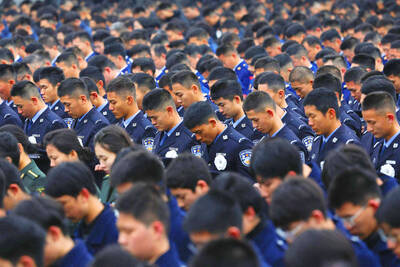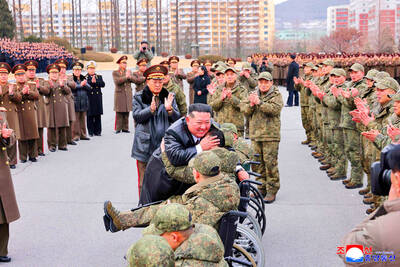A major tsunami struck China’s southern coast in 1076 causing “drastic cultural decline,” Chinese researchers said, in a study with implications for a densely populated region boasting multiple coastal nuclear power plants.
There is a growing body of scientific evidence suggesting an earthquake in the Manila Trench sent a wall of water coursing into what is now China’s Guangdong Province about a thousand years ago.
Now scientists believe they have narrowed down the date to an exact year — 1076 — and say the new data should set alarm bells ringing over whether enough is being done to defend against future tsunamis.
“This study confirms the risk of tsunamis in the South China Sea,” the research teams from the University of Science and Technology and East China Normal University wrote in this month’s issue of Chinese Science Bulletin.
“Such risk should be considered in future planning and construction of nuclear power plant, harbor and petroleum reserve structures on the coastlines of China,” they said.
A number of nuclear power plants sit on China’s southern coast, including at Fuqing, Daya Bay and a soon-to-open plant at Taishan.
The wider area is also one of the world’s most densely populated regions and includes multiple major coastal cities such as Hong Kong, Macau, Xiamen and Quanzhou.
The vulnerability of nuclear power plants to seismic events has become a major cause for concern ever since a 2011 earthquake and subsequent tsunami crippled Japan’s Fukushima Dai-ichi nuclear power plant, the worst nuclear accident since Chernobyl.
The Chinese research team first found evidence of a destructive historical wave on Lincoln Island (Hewu Island, 和五島) located in the middle of the South China Sea, in 2013.
They discovered rocks and corals that had been moved 200m from the shoreline and concluded only a major force of water could have been responsible.
Another team found shards of ceramics in tsunami sediment from the Song Dynasty (960-1279) on Nan Ao Island (南澳島), about 250km up the coast from Hong Kong’s eastern side.
East China Normal University professor Gao Shu (高抒) told Xinhua news agency that the southeast tip of the island used to be a town with official kilns for making porcelain.
Researchers struggled to find any archaeological artifacts from after the suspected wave until the later Ming dynasty.
They also found a shipwreck with 20,000 coins from around the time the tsunami might have struck.
“This cultural evidence indicates a drastic cultural decline caused by the tsunami,” they wrote.
China has begun moves to gather data in the South China Sea about potential tsunami threats, deploying early warning buoys off the Manila Trench last year.

The Burmese junta has said that detained former leader Aung San Suu Kyi is “in good health,” a day after her son said he has received little information about the 80-year-old’s condition and fears she could die without him knowing. In an interview in Tokyo earlier this week, Kim Aris said he had not heard from his mother in years and believes she is being held incommunicado in the capital, Naypyidaw. Aung San Suu Kyi, a Nobel Peace Prize laureate, was detained after a 2021 military coup that ousted her elected civilian government and sparked a civil war. She is serving a

China yesterday held a low-key memorial ceremony for the 1937 Nanjing Massacre, with Chinese President Xi Jinping (習近平) not attending, despite a diplomatic crisis between Beijing and Tokyo over Taiwan. Beijing has raged at Tokyo since Japanese Prime Minister Sanae Takaichi last month said that a hypothetical Chinese attack on Taiwan could trigger a military response from Japan. China and Japan have long sparred over their painful history. China consistently reminds its people of the 1937 Nanjing Massacre, in which it says Japanese troops killed 300,000 people in what was then its capital. A post-World War II Allied tribunal put the death toll

‘NO AMNESTY’: Tens of thousands of people joined the rally against a bill that would slash the former president’s prison term; President Lula has said he would veto the bill Tens of thousands of Brazilians on Sunday demonstrated against a bill that advanced in Congress this week that would reduce the time former president Jair Bolsonaro spends behind bars following his sentence of more than 27 years for attempting a coup. Protests took place in the capital, Brasilia, and in other major cities across the nation, including Sao Paulo, Florianopolis, Salvador and Recife. On Copacabana’s boardwalk in Rio de Janeiro, crowds composed of left-wing voters chanted “No amnesty” and “Out with Hugo Motta,” a reference to the speaker of the lower house, which approved the bill on Wednesday last week. It is

FALLEN: The nine soldiers who were killed while carrying out combat and engineering tasks in Russia were given the title of Hero of the Democratic People’s Republic of Korea North Korean leader Kim Jong-un attended a welcoming ceremony for an army engineering unit that had returned home after carrying out duties in Russia, North Korean state media KCNA reported on Saturday. In a speech carried by KCNA, Kim praised officers and soldiers of the 528th Regiment of Engineers of the Korean People’s Army (KPA) for “heroic” conduct and “mass heroism” in fulfilling orders issued by the ruling Workers’ Party of Korea during a 120-day overseas deployment. Video footage released by North Korea showed uniformed soldiers disembarking from an aircraft, Kim hugging a soldier seated in a wheelchair, and soldiers and officials